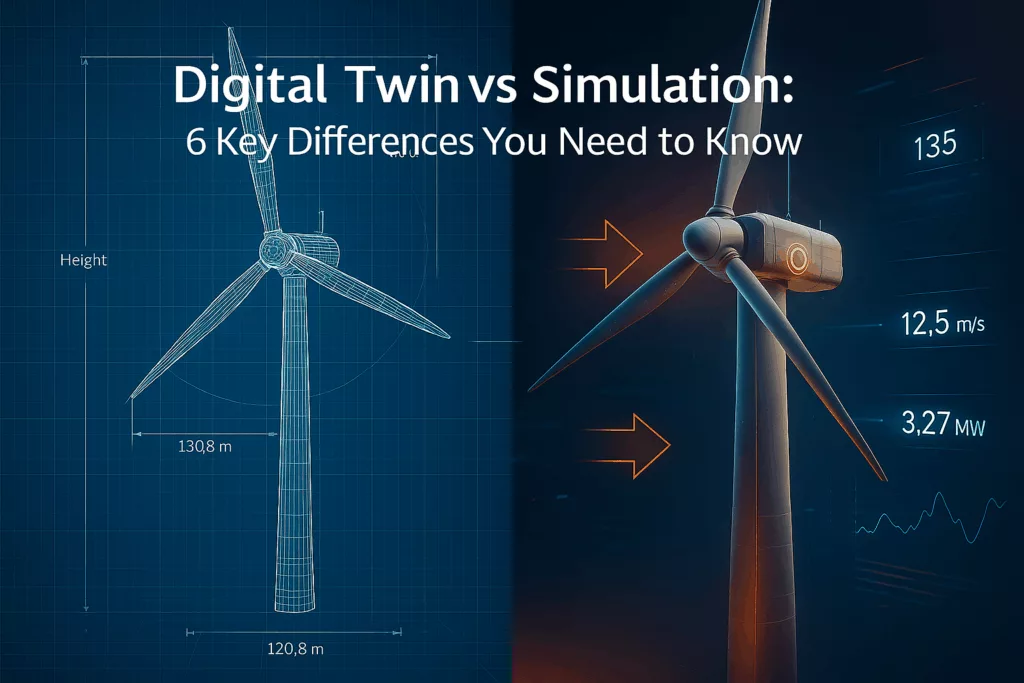Introduction
Understanding the key components of a digital twin is like learning how to give your most critical equipment a voice.? What if a factory engine could tell you it felt stressed, or a wind turbine could whisper that it was running a slight fever? This isn’t science fiction; it’s the reality of a digital twin. It’s more than just a model; it’s a living blueprint, a conscious digital copy of a real-world asset.
But how? How do we build this bridge between the physical and digital worlds? It’s not a single piece of software you install. A digital twin is a living system, an organism built from five key components working in perfect unison. Let’s peel back the layers and look at the anatomy of this technology.
Table of Contents
Think of a digital twin as a living body. To function, it needs all five of its vital systems:
- The Body (The Physical Asset): The real-world object we are mirroring.
- The Nervous System (Sensors & Actuators): The network that feels, listens, and reacts.
- The Circulatory System (Data Connection): The high-speed network pumping data like lifeblood.
- The Brain (Analytics Engine): Where raw data is forged into intelligence and foresight.
- The Face (The Virtual Model): The interface that lets us understand and talk to the twin(2D/3D).
1. The Body: The Anchor in Reality
Every digital twin begins with a body—a physical object in the real world. This is the anchor, the source of truth. Without it, you just have a simulation[Read more about the differences between digital twin and simulation].
This “body” can be anything your business depends on. It could be a single, critical bolt on an airplane wing, an entire fleet of delivery vehicles, or a sprawling manufacturing facility. This is the subject of our observation, the hero of our story. Its reality is what makes the digital twin valuable.
2. The Nervous System: Sensing and Reacting
A body without nerves is just an object. To bring it to life, we need a nervous system. In the digital twin technology stack, this is the role of sensors and actuators.
- Sensors are the nerve endings. They are the listeners, the observers. They feel everything. They measure the flicker of heat from a server, sense the whisper of a vibration in a motor, and track the exact location of a shipping container. They convert the physical world into the language of data.
- Actuators are the muscles. They allow the twin to react. When the twin’s brain makes a decision, an actuator carries it out. It might be an instruction to slow down a conveyor belt, shut off a valve to prevent a leak, or reroute power on an electrical grid.
This constant feedback loop of sensing and acting is what makes the twin dynamic and alive.
3. The Circulatory System: The Data Lifeblood
Now you have a nervous system generating millions of signals. How do they get to the brain? Through the circulatory system: the data connection.
Think of this as the digital veins and arteries. A vast, high-speed network—powered by 5G, fiber optics, and cloud gateways—pumps data from the sensors to the analytics engine. This isn’t a slow trickle; it’s a torrent of information that has to be secure, reliable, and instantaneous. This flow is the lifeblood of the twin. If it stops, the twin is blind and cut off from its physical body.
4. The Brain: Where Data Becomes Wisdom
This is the conscious center of the entire operation. The analytics engine is where the flood of raw, chaotic data is forged into actionable wisdom. So, how does this digital brain think?
It uses a powerful combination of tools:
- Physics and Analytics: It understands the rules of the real world. It knows how metal should behave under stress and how fluids should flow.
- Artificial Intelligence (AI) and Machine Learning (ML): This is the creative, learning part of the brain. It doesn’t just see what’s happening now; it finds hidden patterns in the data to predict the future. It’s the voice that says, “Based on the last six months of vibration data, this bearing will likely fail in 72 hours.”
- Simulation: It can dream. The brain can ask, “What if we ran the system 10% hotter? What would happen?” It runs these scenarios in a safe virtual space, providing answers without risking the real asset.
This brain often lives in the cloud, on powerful platforms from providers like Microsoft Azure Digital Twins, giving it limitless room to think and grow smarter over time.
5. The Face: The Window to the Twin’s Soul
The body is alive, the nervous system is buzzing, and the brain is thinking. But how do we, as humans, understand it? We need a face—an interface. This is the virtual model.
This “face” can look like many things, depending on what you need to see:
- A Detailed 3D Model: A photorealistic twin you can spin, dissect, and explore on a computer screen.
- A Simple Dashboard: A clean, clear set of charts and graphs showing the asset’s health, like a hospital heart monitor.
- An Augmented Reality View: A technician points a phone at a machine, and its “soul”—its temperature, pressure, and performance data—appears as a digital overlay right on top of it.
This is how we communicate with the twin. It’s how we look into its eyes and understand what it’s trying to tell us.
Conclusion: More Than the Sum of Its Parts
A digital twin isn’t just a collection of technologies. It’s a symphony. It’s an organism where the physical body, the sensory nerves, the data lifeblood, the intelligent brain, and the expressive face all work together. By understanding this anatomy, you move beyond seeing it as a complex cost and begin to see it for what it truly is: a new kind of business intelligence, a new partner in your operations, and a new way to predict the future.
Frequently Asked Questions (FAQ)
Can I build a digital twin with only some of these components?
You can build a system, but it won’t be a true digital twin. Without real-time sensors and data flow, you have a simulation. Without an analytics brain, you just have a remote monitoring system. The magic is in having all five components working together, But you can start small and go big step by step.
Does the “brain” have to be AI?
While you can get basic insights with standard analytics, AI and machine learning are what make a digital twin truly predictive and powerful. AI is what allows the brain to learn from history and forecast what will happen next, which is essential for things like predictive maintenance.
Is a 3D model the most important part?
It’s often the most visually impressive part, but not always the most important. The best “face” is the one that gives you the right information, in right way.


